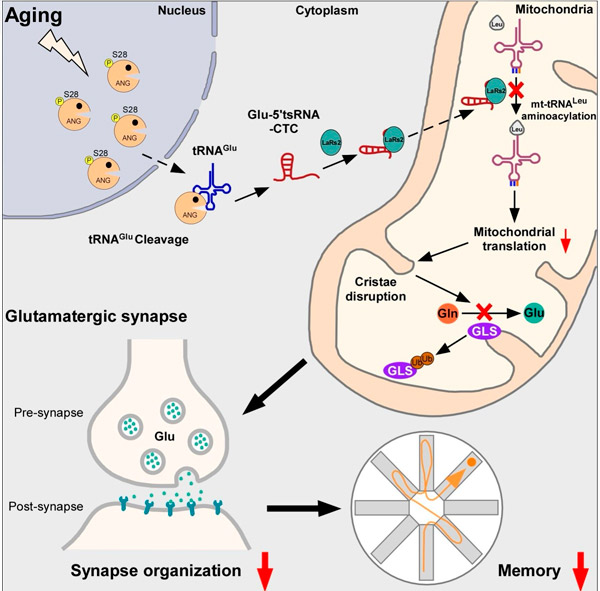Nye publikasjoner
Studie avslører nøkkelrolle for glutamat tRNA-fragmenter i aldring av hjernen og Alzheimers sykdom
Sist anmeldt: 02.07.2025

Alt iLive-innhold blir gjennomgått med medisin eller faktisk kontrollert for å sikre så mye faktuell nøyaktighet som mulig.
Vi har strenge retningslinjer for innkjøp og kun kobling til anerkjente medieområder, akademiske forskningsinstitusjoner og, når det er mulig, medisinsk peer-evaluerte studier. Merk at tallene i parenteser ([1], [2], etc.) er klikkbare koblinger til disse studiene.
Hvis du føler at noe av innholdet vårt er unøyaktig, utdatert eller ellers tvilsomt, velg det og trykk Ctrl + Enter.

En forskningsartikkel publisert i tidsskriftet Cell Metabolism av professor Liu Qiangs team fra University of Science and Technology of China (USTC) avslører den kritiske rollen til glutamat tRNA-fragmenter i hjernealdring og Alzheimers sykdom.
Studien avdekket aldersrelatert akkumulering av Glu-5'tsRNA-CTC, et lite RNA avledet fra transfer-RNA (tsRNA) som dannes fra det kjernekodede tRNAGlu, i mitokondriene til glutaminerge nevroner. Denne unormale akkumuleringen forstyrrer mitokondriell proteintranslasjon og cristae-struktur, noe som til slutt akselererer de patologiske prosessene med hjernealdring og Alzheimers sykdom.
Hjernealdring er en uunngåelig naturlig prosess som resulterer i kognitiv nedgang. Alzheimers sykdom, en nevrodegenerativ tilstand, er den vanligste årsaken til demens hos eldre voksne, der kognitiv svikt er et fremtredende trekk. Mitokondrier forsyner cellene med energi. Forskning har vist at mitokondriell dysfunksjon er nært knyttet til hjernealdring og Alzheimers sykdom.
Mitokondriell Glu-5'tsRNA-CTC forstyrrer mt-tRNALeu-bindingen til leucyl-tRNA-syntetase 2 (LARS2), noe som svekker mt-tRNALeu-aminoacylering og translasjon av mitokondriekodede proteiner. Mitokondrielle translasjonsdefekter forstyrrer cristae-arkitekturen, noe som resulterer i svekket glutaminaseavhengig glutamin (GLS)-dannelse og reduserte synaptiske glutamatnivåer. Videre kan reduserte Glu-5'tsRNA-CTC-nivåer beskytte den aldrende hjernen mot aldersrelaterte defekter i mitokondrielle cristae, glutaminmetabolisme, synapsestruktur og hukommelse.

Skjematisk fremstilling av reguleringsmekanismene til tRNA-fragmenter i hjernealdring og Alzheimers sykdom. LIU Qiang et al.
Liu og teamet hans har belyst den viktige rollen glutamat tRNA-fragmenter spiller i hjernealdring og Alzheimers sykdom, og foreslått nye tilnærminger for å bremse kognitiv nedgang. Forskerne utviklet antisense-oligonukleotider som retter seg mot disse tRNA-fragmentene og injiserte dem i hjernen til gamle mus. Denne intervensjonen forbedret lærings- og hukommelsesproblemer betydelig hos de gamle musene.
I tillegg til å belyse den fysiologiske rollen til normal mitokondriell cristae-ultrastruktur i å opprettholde glutamatnivåer, identifiserte denne studien også en patologisk rolle for tRNAer i hjernealdring og aldersrelatert hukommelsesnedgang.
